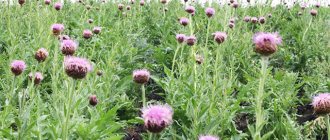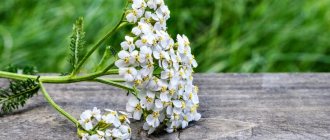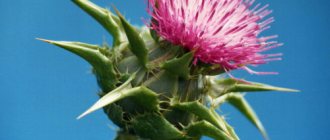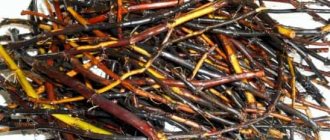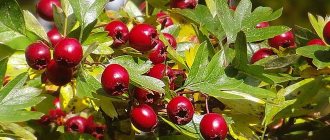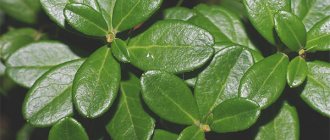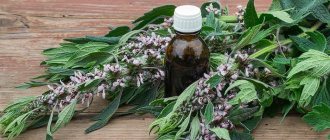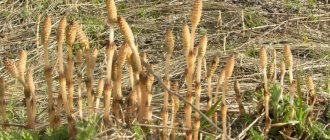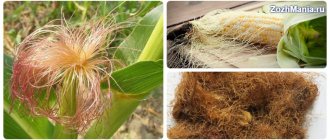Elecampane is a large herbaceous plant, a real gem of folk medicine. People also call it yellow for its flowers that look like a miniature sunflower. Other names are bear ear, meadow oman.
Its effect on health is legendary. Our ancestors believed that it relieves serious illnesses and gives health. Scientific research confirms the benefits of elecampane for the body and its healing properties.
Where does it grow and what does it look like?
The yellow flower resembles a miniature sunflower. It is difficult not to notice: it has a powerful stem, wide leaves and large flowers with a large number of petals. They are collected in inflorescences and bloom in mid-July.
The stems reach a height of two meters or more. It is no coincidence that in reference books the flower is called Elecampane tall. It has massive leaves, easily distinguished by the grayish edge on the back, and a thick, massive rhizome. It smells pleasant and its pungent taste is reminiscent of ginger. The diameter of the flower basket is 5-7 cm. Flowering continues until autumn.
Elecampane loves moist soils, but easily tolerates drought or frost. It can be found in well-lit areas: along the banks of rivers, mountain streams, in meadows, slopes of ravines, near lakes, in forest clearings. In the European part of Russia it lives almost everywhere. In their garden plots, many people pull it out like a weed, without even realizing how elecampane is useful for the human body, and what magic this unpretentious flower contains.
The name of the grass was not given by chance. According to legend, she has nine powers, that is, the ability to cure 9 diseases.
Description of the plant
The perennial plant usually grows in meadows, ravines, lowlands, often near a reservoir. Elecampane grows in the West. Siberia, Belarus, Crimea, the Urals, Wed. Asia, the Caucasus.
In appearance, elecampane resembles a sunflower. Its height can reach 2 meters. The herbaceous plant has elongated, sharp leaves. The large flowers are bright yellow or orange. The erect stem is hard and dense.
For medicinal use, a plant older than 3 years is preferable. Young grass does not contain the required amount of useful elements.
Chemical composition of elecampane
The underground part of the plant has a delicate aroma of violet, it is rich in essential oils (up to 4%), carbohydrates and organic acids. It is a valuable source of inulin, although it contains less of this substance than chicory. Greens and fruits contain essential oil, ascorbic acid, and tocopherol.
The leaves contain a lot of tannins and flavonoids: quercitrin and isoquercitrin. rhizomes contain organic acids and bitterness. They contain bitterness, micro- and macroelements, gums, resins, alkaloids, vitamin E, and pectins.
ABC of herbs. Elecampane tall
Elecampane (Inula heienium) (inula - sun in Latin), family Asteraceae - Compositae, or asteraceae - Asteraceae. Popular names - elecampane root, 9sil, elecampane, bloodroot, holyuka, oman, smart, uman, meadow aman, wild sunflower, yellow buttonweed, animal grass, bear's ear, alanth, divosil, bear's ear, rough grass.
Elecampane is one of the most popular medicinal plants, the healing properties of which have been known since ancient times. As ancient beliefs say, “nine powers” are contained in this plant, which is where its name comes from. This is a perennial herbaceous plant from the Asteraceae family, up to 2 meters high. The stem is thick, the leaves are alternate, large, stiff-haired above, soft-tomentose below. The upper leaves are sessile, the lower leaves are petiolate. The flowers are golden-yellow, collected in large baskets, sessile solitary at the ends of the stems. The rhizome is yellow-brown in color, short, multi-headed, roots up to 50 cm in length. The fruit of the elecampane is a tetrahedral brown achene, about 4-5 mm long, with a tuft twice the size of the achene. Blooms in July-August.
Elecampane is widespread in the European part of Russia, the Caucasus, Western Siberia and Central Asia. It grows along the banks of rivers, lakes, in wet meadows, in places where groundwater comes out, among bushes, in deciduous forests. The plant is popular among the people and, due to increased collection of rhizomes, is now found in small quantities.
Rhizomes, roots and leaves are used for medicinal purposes. Rhizomes are collected in the fall, mainly in October or spring. When collecting, dig up the root system within a radius of about 20 cm from the stem to a depth of about 30 cm and, holding the stem, pull the rhizome out of the soil, trying not to break off the thick roots. To speed up the drying process, the root is cut into pieces. Dry in the shade. Store in boxes lined with paper inside. Leaves are taken from young plants and air dried. The shelf life of raw materials is 3 years.
Elecampane contains essential oil, inulin (45%), triterpines, lactones, saponins, resins, mucous and bitter substances, vitamin E. The composition of the essential oil includes helenin and alanthic camphor, as well as a small amount of proazulene.
Elecampane has an expectorant, improves digestion and metabolism, mild diaphoretic, anthelmintic, antiseptic, anti-inflammatory and sedative effect. It is considered a good remedy for healing pulmonary ulcers. The roots of the plant are recommended for diabetics. Elecampane is also useful as an activator of mental and muscular activity. It is used internally in the form of infusion, decoction, powder, externally - in the form of ointment and decoction.
The ancient Greeks and Romans believed that elecampane cleanses and strengthens the body, increasing human strength. A.V. Suvorov, when crossing the Alps, ordered that soldiers be given an infusion of elecampane to increase their strength. In ancient Tajik medicine it was believed that elecampane improves mood and strengthens the heart.
In Chinese medicine, the roots and rhizomes of elecampane are used as an expectorant, anti-inflammatory, and antidiarrheal agent. Used for diseases of the lungs, intestines, and skin.
In German folk medicine, an infusion of rhizomes and roots is used to enhance general metabolism, as an appetizing remedy and a means of stimulating the activity of the gastrointestinal tract; in the form of elecampane tea, it is used for diseases of the respiratory organs.
In Indian medicine, elecampane is used for chronic bronchitis and rheumatism.
In Austria, elecampane is used in the form of a decoction, cold infusion for lung diseases and as an anthelmintic.
Tibetan medicine uses the aerial part of the plant for sore throat, diphtheria, and various gastrointestinal diseases. The inflorescences are used for pneumonia as a wound healing agent. They are part of complex recipes that are used for rheumatism and atherosclerosis.
Recipes for using elecampane
- To stimulate the function of the kidneys and adrenal glands,
you can use the following mixture - stinging nettle, elecampane root, rose hips, parsley, pine bark, grape seeds, cranberry fruits, peanut husks - in equal parts. Infusion: 2 tbsp. Pour spoons of the mixture into 2 glasses and boiling water, leave for 25 - 30 minutes, strain. Drink 100-200 ml before meals. Course: 2 - 3 months. - For hypertension
, mix equal parts elecampane roots and tansy flowers. Pour 1 teaspoon of the mixture with 2 cups of boiling water and steam for 1.5 hours. Drink half a glass 3 times a day 2 hours before meals. - An effective remedy for rheumatism.
It is necessary to mix equal parts of elecampane and burdock roots. Pour 1 tablespoon of the mixture into 1 cup of boiling water, leave in a warm place for 20 minutes, strain. Take 1 tablespoon 3 times a day 20 minutes before meals. This infusion can also be used for warming compresses. - For stomatitis,
boil 20 g of elecampane roots for 5 minutes in 200 ml of water, leave in a warm place for 4 hours. Drink 1 tablespoon 34 times a day half an hour before meals. - For allergies
(cold, medication, food), mix equal parts of elecampane, licorice and marshmallow roots. Place 2 teaspoons of the mixture in 2 glasses of cold water, close the lid and leave for 810 hours (leave overnight). Drink the infusion, 1/3 cup slightly warmed, with honey. - Fast-acting expectorant collection
- mix elecampane root, licorice, marshmallow in equal quantities, pour 2 teaspoons of the collection with 2 glasses of boiled water at room temperature and leave for 8 hours. Take 1/3 cup infusion, slightly warmed with honey, for 10 days. Drink 2 glasses per day. - Infusion for peptic ulcer of the stomach and duodenum.
1 tablespoon of crushed elecampane root per 400 ml of water. Leave for 10 hours at room temperature. Drink ½ cup 3 times a day, warmed, 30 minutes before meals for 7 - 14 days. - For acute bronchitis,
1 tablespoon of roots should be poured with a glass of cold boiled water in the evening. The roots must be infused in a sealed container for at least 8 hours. In the morning, stir well, let the suspension settle and drink one sip every hour. Continue for several days. - In case of inflammation of the kidneys,
it is necessary to make a collection - wild strawberry leaves, elecampane and burdock roots - 1 part each; nettle leaves, St. John's wort and fragrant chamomile flowers - 2 parts each; oregano herb, May birch leaves and flaxseed - 3 parts each. Grind all ingredients and mix well. Pour two tablespoons of the mixture into 0.5 liters of boiling water and leave overnight in a thermos. Take 100 ml 4 times a day before meals, warm. - For sprained ligaments,
elecampane root can be used as a compress from a strong decoction: 2 tablespoons per glass of water, simmer over low heat for 5 minutes, then leave for 2 hours. Poultices made from fresh roots are even more effective. - Externally, a concentrated infusion or decoction of elecampane rhizomes and roots can be used in the form of baths, washes, and compresses for various skin diseases
, such as rash, scabies, eczema, itchy skin, and lichen. - Fresh elecampane leaves, when applied to wounds, help them heal faster, accelerate the maturation of abscesses, and soften tumors.
- as a general tonic
at the rate of 1 g 3 times a day, washed down with water.
Contraindications
- severe cardiovascular diseases
- kidney diseases
- gastritis with low acidity, since decoctions and infusions from elecampane roots reduce the secretion of digestive enzymes in the stomach
- for hypotension, decoctions and infusions of elecampane root should be used with caution
- pregnancy
Elecampane
Use in cooking
- Elecampane rhizomes are used as a spice, replacing ginger in the food, canning, and confectionery industries.
- Elecampane adds flavor to compotes and baked goods.
- Recipe for apple compote with elecampane: Add 300 g of sugar to 2 liters of boiling water, stirring until it is completely dissolved, add 600 g of sliced apples and 100 g of chopped fresh or 20 g of dried elecampane roots, cook for 8 - 10 minutes, add 2 tablespoons lemon juice.
- General strengthening drink with elecampane: 300 g of fresh or 50 g of crushed dry elecampane roots, half a glass of apple juice, 1 liter of water. Cut fresh roots into pieces and boil in water for 20 minutes, dry roots - 25 minutes. Strain the broth, add apple juice, stir and cool. Take 3 tablespoons with honey 3 times a day before meals as a strengthening and preventive remedy for any disease. Take 20 - 30 days.
Interesting Facts
- The rhizomes of elecampane were previously used to produce blue paint.
- Essential oil is a good antiseptic.
- Elecampane will be attractive in the garden as an ornamental plant. It's quite easy to grow. You need to choose a sunny area. It is better to sow seeds before winter. The distance between rows should not be less than 70 cm. If the soil is acidic, lime must be added.
- It was in the roots of elecampane that inulin was discovered as a chemical substance in 1804, and only then it was discovered in other plants of the Asteraceae family. This substance owes its name to elecampane (Inula).
Bibliography:
- “Medicinal plants and methods of their use among the people”, Nosal M.A., Nosal I.M.
- “Herbalist for men”, Efremov A.P.
- “Plants are your friends and foes”, R.B. Akhmedov
- “Odolen is grass”, R.B. Akhmedov
- “Medicinal plants in folk medicine”, V.P. Makhlayuk
- “Medicinal plants on a personal plot”, E.L. Malankina
Elecampane: medicinal properties and contraindications
There is not much scientific research on the healing power of the plant. They often contradict each other. It is known for sure that preparations made from it tone up, improve metabolism, and give energy. They reduce the secretory activity of the bronchi. This leads to easier sputum discharge.
Decoctions maintain good health, relieve migraines, dizziness, and heart pain. Drinking reduces toothache, relieves discomfort in arthrosis, arthritis, osteochondrosis, and problems with the sciatic nerve. It is taken for irregular or painful periods, diabetes, and hemorrhoids. It reduces the discomfort of colitis and improves liver function.
The beneficial properties of elecampane are contained in unique components concentrated underground. For healing, rhizomes are dug up. Their main value is in their essential oil.
In order not to harm your health, you need to understand what elecampane helps with, as well as what diseases it can relieve . The plant is included in preparations prescribed for whooping cough, bronchial asthma, and respiratory infections, including tuberculosis. Its components improve metabolic processes in the gastric mucosa.
Sometimes in the literature there is data on the use of leaves. They are applied to damaged areas of the skin for speedy healing. It is believed that they disinfect and prevent inflammation.
In the old days, a piece of the stem was carried with them as a talisman or left in the house to protect against evil spirits.
Liquid preparations exhibit expectorant, antiseptic and weak diuretic effects. Many people notice that they help with tachycardia and slightly reduce blood pressure. In addition, they are used for the following problems:
- irregular periods,
- intestinal disorders,
- decreased immunity,
- cough,
- diseases of the genitourinary system,
- impaired digestion.
It has been established that aqueous infusions of the plant slow down intestinal function and increase the outflow of bile. This feature is used in medicine. Not long ago, tablets called Alanton were produced from the rhizome extract. They were prescribed for cholecystitis, GIVP, long-term non-healing ulcers of the stomach and duodenum.
Currently, the state registration of this medicine has expired, and the plant can be purchased at the pharmacy in the form of natural raw materials. It is sold in cardboard packs or filter bags as an expectorant herbal remedy.
Useful properties of elecampane root
The root of the bush cannot be used in its natural form, as it is bitter and difficult to digest. It is usually used for decoctions that can lower sugar levels, strengthen the immune system, and kill harmful microbes. The root is a source of beneficial properties, as it contains many biological components that have a beneficial effect on health. The inulin in the composition has a positive effect on metabolism, and the resins have a laxative effect. The alkaloids contained in the herb relieve pain.
- Elecampane root, used in decoctions, is used for many ailments:
- inflammation in the digestive system;
- ailments related to the kidneys and liver;
- lung diseases and increased cough;
- skin diseases;
- diabetes;
- insufficient amount of blood in the body;
- high blood pressure;
- has a beneficial effect on the reproductive organ system;
- treatment of hemorrhoids;
- inflammatory processes in the lungs (tuberculosis and so on).
Inflorescences and leaves are also used in treatment. The first is used to prepare decoctions that help with inflammation in the nose, ears and throat. Also used to strengthen the heart muscle and for headaches. The leaves of the herb are effective in treating the following diseases;
- inflammation of the gums;
- diseases associated with the oral cavity;
- atherosclerosis;
- intestinal tract problems;
- venereal diseases;
- ringworm.
Fresh leaves are often applied to burns, wounds and other inflamed areas. Elecampane is in demand among women, as it helps with such diagnoses as infertility. But the process is long. Don't expect the effect to show up quickly. The root contains vitamin E, which stimulates the functioning of the ovaries. During pregnancy, taking the decoction reduces various risks associated with miscarriage. To enhance the effect, other medicinal plants are added to elecampane. The bush has a beneficial effect on the menstrual cycle, improving it and relieving pain syndromes. The main thing is to take according to the dosage (one hundred milliliters per day).
A man with nicotine addiction can use elecampane to get rid of it. It is no secret that over the years of smoking a film appears on the bronchi, causing uncontrollable coughing and difficulty breathing. The decoction is aimed at helping to remove this film. In medicine, it is also used for the sexual sphere, namely to enhance potency, as well as improve the composition of sperm.
Elecampane herb: medicinal properties
The plant demonstrates antipyretic, fungicidal, antiviral and mucolic effects. Its components accelerate the healing of stomach ulcers and skin lesions. The leaves were applied to wounds and ulcers to relieve dermatitis, eczema and various inflammations.
There is a popular belief that elecampane cures male infertility, eliminates pathologies and promotes the conception of healthy offspring.
The antihelminthic effect of the root is well known. It contains bitterness that parasites cannot tolerate. Herbalists and traditional healers advise swallowing dry powder before eating in an amount that fits on the tip of a knife. If this option is unacceptable, then prepare a decoction:
- add 400 ml of hot water to 20 grams,
- leave for 8-12 hours,
- squeezed through gauze,
- drink half a glass twice a day.
The ancient Slavs knew well the benefits of elecampane root. They combined it with other components: yarrow, birch leaves, hawthorn. They were used to treat bronchitis and other respiratory diseases. It is included in collections to get rid of pustular skin diseases. Here is an example of one of them:
- horsetail,
- elecampane,
- St. John's wort,
- calendula,
- plantain,
- pharmaceutical camomile,
- sage.
All ingredients are mixed in equal proportions, brewed in the standard way, and taken orally half a glass three times a day. The liquid can be diluted with water and used for washing or added to the bath.
How to take elecampane for cough?
The plant is the number one remedy for strengthening the respiratory system. Its antiseptic and diaphoretic effect has been used for colds and complications for many generations. The infusion thins mucus and removes it from the bronchi.
To prepare it, take 2 tbsp. l. raw materials, pour 250 milliliters of boiling water, cool and drink in small sips. The following ingredients will help strengthen your immune system:
- mix a decoction of ground raw materials and freshly squeezed apple juice,
- dilute 6 grams of honey,
- drink half a glass on an empty stomach.
It is recommended to drink the decoctions warm. The sensation should be comfortable and not cause a burning sensation in the mouth.
Another recipe:
- finely ground dry product is combined with an equal volume of honey and aloe juice,
- mix thoroughly with a wooden spatula.
Place the mixture in the refrigerator and take ½ teaspoon orally on an empty stomach or externally for skin problems.
For beauty
The plant has long been used to strengthen hair. Healing infusions inhibit the formation of dandruff and stop hair loss. The strengthening collection is prepared as follows:
- take St. John's wort, burdock root and elecampane;
- mix in equal proportions;
- brewed in the standard way;
- cool;
- filter through a sieve;
- diluted;
- rinse your head.
For dandruff, a mask that is applied to the hair and thoroughly rubbed into the scalp has received good reviews. To do this, take 1.5 tbsp. l. powder, brew half a liter of boiling water, leave for half an hour, filter.
What should you pay attention to?
Elecampane has not only medicinal properties, but also contraindications. In reference books there are often indications of its ability to induce menstruation. This action can be dangerous in the early stages of pregnancy and can lead to its termination, so any treatment should be carried out only under the supervision of a doctor and with his permission. In addition, contraindications include:
- individual intolerance,
- heart and vascular diseases,
- gastritis or ulcer in the acute phase,
- excessive blood viscosity,
- age up to three years,
- renal failure.
Sometimes allergic reactions, heartburn, and intestinal cramps may occur. If any undesirable symptoms occur, you should stop taking it and consult a doctor.
Elecampane is tall. Botanical description and characteristics of the plant
photo of a blooming elecampane in its natural habitat
Habitat of growth, chemical composition and beneficial properties of the plant
Description: elecampane grass is a plant reaching 2 meters with an erect grooved stem, elliptical large basal leaves with denticles along the edges, tapering towards the top of the plant, covered with tomentose pubescence. The rhizome is short, thickened with small lateral shoots, has healing properties, a unique aroma and a bitter-burning taste. It blooms with yellow tubular-ligulate flowers collected in a brush. The flower is similar in appearance to a sunflower, but smaller in size. In autumn the fruits ripen - oblong achenes with brown tufts.
Where it grows: the elecampane plant grows in the forest-steppe and steppe zones of the European part, Kazakhstan, Central Asia, Africa, Europe, the Caucasus, the Urals and Western Siberia.
Elecampane can be found in forests, along rivers and lakes, and in meadows. It is grown in gardens and household plots as a cultivated plant.
Elecampane is grown as an ornamental plant to decorate the landscapes of parks and squares
Chemical composition
The plant contains a lot of substances beneficial to the body:
- Essential oil;
- Saponins;
- Inulin (up to 44%);
- Polysaccharides;
- Alkaloids;
- Gelenin;
- Vitamins E and C;
- Resins, mucus, bitterness, gum, pectin.
Elecampane root - medicinal properties and contraindications
Elecampane has the following beneficial properties:
- Antiseptic;
- Choleretic;
- Antispasmodic;
- Anti-inflammatory;
- Hemostatic;
- Expectorants;
- Diuretics;
- Anthelmintic.
the plant, due to its rich chemical composition, has a wide range of medicinal effects on the human body
Benefits of the plant
- Has a beneficial effect on the digestive organs;
- Slows down intestinal motility and secretory activity;
- Stimulates the formation and secretion of bile;
- Increases blood circulation in the gastric mucosa;
- Increases the amount of bound hydrochloric acid and reduces the content of pepsin;
- Normalizes metabolism;
- Improves the process of digestion and absorption of food;
- Strengthens capillaries and accelerates the regeneration of the gastric mucosa;
- Inulin cleanses the body of harmful substances and heavy metals;
- Invert sugar is converted into a glucose isomer and replaces sugar in people with diabetes;
- Reduces intoxication in case of poisoning;
- Reduces the frequency and amplitude of heart contractions;
- Calms the nervous system, improves mood;
- Reduces pain in joints and spine;
- Improves calcium absorption, strengthens bone tissue;
- Helps with diseases of the upper respiratory tract, has an antiseptic and expectorant effect;
- Fights skin diseases;
- Helps with solving gynecological problems;
- Stimulates sexual potency;
- Increases appetite;
- Used in cosmetology for skin and hair care.
What does elecampane treatment help with?
properly prepared raw materials have all the beneficial properties of fresh roots
The use of elecampane will have a positive effect on the following diseases:
- Peptic ulcer of the stomach and duodenum;
- Bronchitis, pneumonia, cough with sticky sputum;
- Diseases of the liver and gall bladder (pyelonephritis, cholecystitis, jaundice);
- Rheumatism, radiculitis, gout;
- Cold infections;
- Diabetes;
- Failure of the menstrual cycle;
- Hypertension;
- Inflammation of the sciatic nerve;
- Diarrhea and constipation;
- Bone tuberculosis;
- Neurodermatitis, eczema, scabies, boils;
- Wasting and goiter.
Contraindications
It is not recommended to take the plant if:
- Chronic kidney pathologies;
- Increased blood viscosity and tendency to thrombosis;
- Severe lesions of the cardiovascular system;
- Atonic constipation;
- Pregnancy;
- Children under 3 years of age;
- Individual intolerance.
Collection and preparation of elecampane
in order to obtain high-quality raw materials, roots should be harvested in environmentally friendly places, away from highways and landfills
The roots are harvested in the spring before flowering or in the fall; plants are chosen that are at least 3 years old; they contain the largest amount of biologically active substances. Elecampane is dug up, the roots are cleared of soil, washed, and small branches are removed. The prepared roots are cut into pieces and dried in fresh air in a well-ventilated place protected from direct sunlight or in an electric dryer. The finished raw material breaks easily; when cut, it has a yellow-white color with shiny specks - these are accumulations of essential oils. The taste of the roots is bitter-spicy.
Leaves and flowers are collected in summer from young plants. Dry naturally or in dryers. Raw materials are stored in a cool, dry place in an airtight container for 3 years.
Cooking method
Popular wisdom has brought down to this day recipes for infusions of water, vodka or red wine:
- A tablespoon of raw material is placed in a ladle, 200 ml of hot water is poured, covered with a plate, and kept in a water bath for half an hour. Then the liquid is cooled, filtered, and the volume is adjusted to 200 ml. Drink 100 grams three times a day, store for no more than 2 days.
- 30 grams of crushed elecampane are placed in a thermos, poured with boiling water, left for an hour and a half, and filtered.
- Two tablespoons of powder are poured into a bottle with a high-quality alcohol-containing drink and left for 4-5 days. Traditional herbalists prepared this tincture for headaches, palpitations and whooping cough.
- Pour a bottle of red wine into a saucepan, add three tablespoons of root, put on fire, and bring to a boil. Cool the resulting mixture, strain through 4 layers of gauze and refrigerate. The liquid is taken in 15 mg doses to strengthen, treat stomach diseases, increase defenses and tone.
Use of elecampane root, recipes
Water decoction:
- Herb root - one tbsp./spoon;
- water – two hundred and fifty milliliters;
- honey - five grams.
Preparation: water is mixed with elecampane and left to boil for twenty-five minutes. Once it has cooled down, we begin filtering the content. If in the end you have less than two hundred milliliters, then you can add a little boiling water. Next, honey is added to remove the bitterness. The decoction is consumed one hour before meals. The dosage is directly related to the ailment for which it is used.
Wine decoction:
- elecampane root - four tbsp./l;
- wine – one bottle 0.75 l. (use natural options).
Preparation: the ingredients are mixed and boiled for ten minutes. After the broth has cooled, it can be consumed. No need to filter. You should take several tablespoons per liter during the day. The course can last several days. The decoction can dilate blood vessels and lower blood pressure, as well as cope with fatigue.
Tincture of elecampane root:
- elecampane root – one hundred grams;
- vodka or diluted alcohol - 0.5 l.
Preparation: alcohol is combined with water in equal parts, then elecampane is added. The mixture is placed in a glass container and stored in a dark place for two weeks. Next, the roots are squeezed out and the composition is filtered. Take fifteen grams every day.
Main Application
Elecampane has found application not only in medicine, but also in the food, confectionery, and alcoholic beverage industries. Some sources contain data on its use in dietary nutrition. Soups and compotes are prepared from the underground part of the plant.
Elecampane can be used instead of ginger to flavor culinary products, when canning, as a spice or as a food additive.
The infusion is used for external treatment. It is effective for eczema, inflammation, and irritation.
The dried and crushed product can be purchased at the pharmacy. The instructions most often indicate use only as a mucolic agent. Recently, dietary supplements from various manufacturers have begun to appear, their scope of application is somewhat wider.
How best to consume
A medicinal decoction or infusion is usually taken internally, or less often powder and oil. Ointment and oil are used externally.
Decoction
The decoction treats diabetes, pancreatitis, and gynecological inflammation. It is useful for them to rinse the mouth for stomatitis and toothache.
A cloth soaked in the broth is applied to a painful joint with arthritis.
You can quickly get rid of a cold by adding a spoonful of honey to a portion of liquid.
The medicine is prepared on a water or wine basis.
Method 1, preparation:
- place 1 tbsp. l. plant raw materials in a glass container, pour a glass of water;
- put in a water bath, boil for 20–25 minutes;
- remove, cool slightly;
- squeeze out pieces of root, strain the broth;
- the volume of liquid should be 200 ml. If it turns out less, add water.
Take warm 40–60 minutes before meals. The dosage depends on age and disease.
2nd method . It is believed that the recipe was invented by the ancient Greek physician Asclepius. Wine decoction cleanses blood vessels, relieves physical fatigue, and normalizes blood pressure.
You will need 10 large spoons of root, 2 liters of dry red wine (or 1 spoon per bottle of Cahors).
Preparation:
- pour the raw materials with wine (the pan should be enamel or glass);
- close the lid, cook for 10 minutes;
- cool at room temperature.
No need to strain. When you have a cold, it is useful to add a spoonful of honey.
Infusion
Prepared on a water or alcohol basis . In the first case, you can use a thermos. Pour a teaspoon of raw material into a glass of hot water and leave for 10 hours.
Drink in equal portions throughout the day.
Used in the treatment of bronchitis, pneumonia, hemorrhoids, skin diseases (as a blood purifier).
Alcohol tincture of elecampane has a lot of medicinal properties and is effective for diabetes, enuresis, and infertility (you shouldn’t forget about contraindications either, we’ll talk about them below).
Preparation:
- 100 g of raw materials pour 500 ml of medical alcohol;
- leave in a dark place for two weeks;
- Squeeze out the roots and strain the infusion.
Instead of alcohol, you can use high-quality vodka (200 ml per 100 g of root).
The famous “Avicenna wine”, which cleanses the body, can also be classified as infusions . 800 g of roots are infused for three months in 10 liters of grape must (can be replaced with dry red wine).
Ointment
Excellent healing of wounds without leaving scars. Helps with eczema, diathesis, burns.
To make it, you will need a spoonful of powdered rhizome and unsalted lard (5 tbsp) rolled in a meat grinder. Mix the ingredients, melt over low heat, stirring.
Oil
Elecampane essential oil is sold in pharmacies . It acts as a powerful antiseptic.
It’s easy to prepare it yourself: pour 100 g of chopped roots with 1 liter of warm olive oil. Leave in a dark place for 1 month (another option is to leave in the sun for two weeks).
Properly prepared medicine is a dark liquid with a characteristic spicy odor.
Used for inhalation, massage, treatment of wounds and trophic ulcers. Two drops added to tea will improve the taste of the drink and protect against viruses during the cold season.
How to prepare?
As a medicine, rhizomes weighing 0.5-1.5 kg are collected for at least 3 years. This is usually done in the fall after the fruits ripen or in early spring. They are dug out of the ground, shaken off, thin branches and remains of the stem are removed, washed, and then cut into finger-thick pieces and laid out in the attic or other suitable room for drying.
Processing in a dryer is allowed, but the temperature should not exceed plus 45 degrees. The product is stored in glass containers for no more than two years.
The herbaceous perennial is a powerful herbal remedy. When used correctly, it will provide great health benefits. The main thing is to take precautions and consult a specialist before starting treatment.
Description, distribution, method of procurement
Elecampane is a perennial of the Asteraceae family , a close relative of asters.
The low-branched, grooved, strong stem grows up to two meters. The long lower leaves are alternate. They are densely pubescent and velvety to the touch. The upper leaves are lanceolate, smaller, and rigid.
The ends of the stems are decorated with yellow flowers collected in baskets.
A valuable healer is hiding underground: a knotty, fleshy, brown outside, whitish rhizome inside. It is used in official and folk medicine.
Finding elecampane is not difficult . It is distributed throughout central Russia and is found in Central Asia and the Caucasus.
It feels great in garden plots, but is demanding on the soil: it will give a good harvest of roots and rhizomes in well-fertilized peat or loamy beds.
Mass flowering begins in the second year of life . Lasts from July to the end of September.
The beginning of fruiting - the appearance of a brown tetrahedral box with a grayish hairy tuft in place of the flower - is a signal for the preparation of medicinal raw materials. It is carried out before frost begins.
Elecampane can be collected in early spring, but the medicinal properties are considered less pronounced.
Harvesting method:
- dig up the rhizome along with the roots. To do this, dig up the plant to a depth of 30 cm within a radius of up to 25 cm from the stem;
- remove soil, rinse, dry a little;
- divide into small pieces;
- Dry with good ventilation, toss from time to time.
Properly prepared roots break easily.
This is a photo of the medicinal herb elecampane; below we will look at the medicinal properties of its roots and contraindications:
Planting and caring for elecampane
- Flowering: within a month from July.
- Planting: sowing seeds in open ground - in the second ten days of May, after stratification of the seed material, or before winter.
- Lighting: bright sunlight.
- Soil: nutritious, moist, breathable, drained, preferably loamy or sandy loam.
- Watering: in the first year - frequent and plentiful, especially during the periods of budding and flowering. In the future, the plant itself will begin to obtain moisture for itself, therefore, from the second season, watering is carried out only during a prolonged drought.
- Feeding: Nitroammofoska solution twice a season: as soon as the plant forms a rosette of leaves and when ground shoots begin to grow.
- Reproduction: seed.
- Pests and diseases: practically not affected.
- Properties: is a well-known medicinal plant with anti-inflammatory, expectorant, diuretic, diaphoretic, antiseptic and anthelmintic effects.
Read more about growing elecampane below.
Growing
Growing culture
Culture has a democratic and undemanding attitude towards growing conditions. It takes root well in loose soil with sufficient moisture. Not afraid of cold weather. However, love the light and the sun. Does well in soil rich in minerals, especially calcium.
To plant elecampane on your site, you need to know that the plant reproduces by seeds or by dividing the root. Seed propagation is more common due to the better survival rate of the crop. However, this type of cultivation requires a picking procedure.
This will give the maximum speed of root strengthening, which guarantees the survival of the plant. You can plant seeds in the ground, but in a certain season - early spring or late autumn. When planting, the soil needs to be moistened abundantly.
Elecampane grows quickly, producing about 6 flowers in the first year. If you want to grow a plant by division, then this is allowed from the second season. The root is divided in half so that each half has at least one bud.
Medicinal preparations based on elecampane
Official medicine has a more than positive attitude towards the use of the roots and herbs of the drug in the treatment of various diseases, since the use of elecampane in the most suitable form, be it tincture, ointment or decoction, promotes favorable changes in the human body. For the production of pharmaceuticals, as a rule, the root and basal system of elecampane are used, since it contains a concentrated part of the beneficial substances. Today, there are the following drugs that contain elecampane:
- Elecampane syrup;
- elecampane root and rhizome;
- Elecampane herbal tea (in the form of herb);
- Alantolactone;
- Alanton.
Clinical studies have confirmed that the use of elecampane in its pure form does not cause interaction with other medications and can be prescribed by a doctor as an adjuvant to the main prescribed therapy.
Growing elecampane
Planting elecampane
If you decide to grow an elecampane plant on your site, then when choosing a location, take into account its need for good lighting and warmth. Elecampane needs soil that is breathable, nutritious and moist, with a sandy or loamy composition. It is advisable to sow elecampane after clear fallow, and then you can count on a high harvest. You need to prepare the area for sowing in advance: dig up the soil to the depth of a spade with humus or compost at the rate of 5-6 kg per m², add a phosphorus-potassium mixture (40-50 g/m²) and harrow it. Before sowing, nitrogen-containing fertilizers are scattered over the area, embedded to a depth of 10-15 cm, after which the surface is compacted.
Sowing of elecampane seeds is carried out in the spring (in the second ten days of May) or before winter. The seed does not need preliminary stratification, but for convenience, the seeds are mixed with sand in equal parts. For one row one meter long you will need approximately 200 elecampane seeds. The depth of planting in light soil is 2-3 cm, in heavy soil - 1-2 cm. Row spacing is left 60-70 cm wide. Shoots will appear no earlier than the air warms up to 6-8 ºC, but elecampane grass grows and develops best when temperature 20-25 ºC. Under normal weather conditions, about two weeks pass from the moment of sowing until the seeds germinate. A few days before the emergence of seedlings, the area is harrowed across the seeding rows, removing large lumps of earth and thread-like weed seedlings.
- Lobularia: cultivation and care in open ground
Elecampane is also propagated by dividing the rhizomes. This method in the southern regions is carried out both in the spring and in August, and in the northern regions - only in the spring, during the period of leaf blossoming: the rhizome is dug up, cut into pieces, each of which should have 1-2 vegetative buds. They are planted at a distance of 30 to 65 cm from each other to a depth of 5-6 cm, with the buds facing up. First, each hole must be shed with warm water and fertilizer mixed with soil must be added. After planting, the surface is compacted, watered and mulched. In the first season, the rooted plant will sprout, which by the end of summer will reach a height of 20-40 cm.
Caring for elecampane in the garden
From the moment the seeds germinate, caring for elecampane consists of thinning the seedlings, watering the area, weeding and loosening the soil around the plants. The first year, elecampane grass grows very slowly, and by the end of summer it reaches a height of no more than 30-40 cm. By this time, the plants have formed a root system and rosettes of leaves. Elecampane will bloom no earlier than July of the next season, and its flowering will continue for about a month.
The elecampane flower needs a lot of moisture, especially during the period of budding and flowering. Its penetrating root system extracts water from deep layers of soil, so the plant will only need to be watered during prolonged drought. As for weeding, you will have to do it regularly in the first year of life, and as soon as the elecampane grows up, it will not be afraid of any weeds.
At the stage of formation of the elecampane's basal rosette of leaves, and then again - after 3-4 weeks, when ground shoots begin to grow - the plant is fed with Nitrophoska. In the fall, before the onset of the dormant period, phosphorus-potassium fertilizers are applied to the soil.
How to properly prepare and store plant materials
Collection rules:
- You should not collect the roots of young plants; the best age is 2–3 years.
- Collection should be done in spring or autumn.
- It is worth paying attention to the quality of the plant root: good raw materials should not be damaged by insects, have blackened areas, and should also be free of plaque and mold.
It is better to collect raw materials in dry, cloudy weather.
Procurement rules:
- Carefully dig up the roots with a shovel, being careful not to damage them.
- Shake off the soil from the roots.
- Use scissors or a garden knife to remove the rhizome and stem.
- Rinse the root in cool water.
Storage rules:
- The roots are stored in linen bags, glass or wooden containers.
- Shelf life: 3 years.
- The storage room should not be damp or cold, or stuffy.
The quality of future raw materials depends on proper collection and storage conditions.
Elecampane for cough
Essential oils and saponins in the plant have an expectorant, anti-inflammatory and mucus-secreting effect. Therefore, elecampane root is recommended for acute and chronic cough. After taking it, the mucus thins and is removed with sputum. In addition, the bitter substances contained in the root of the plant strengthen the immune system and are recommended for bronchial asthma when the body is weakened.
To prepare a cough decoction, pour 300 ml of boiling water over one and a half tablespoons of elecampane roots and simmer over low heat for 15 minutes. Cool the broth, drink three teaspoons every three hours.
You can prepare a herbal mix. Here's how to brew elecampane root for cough correctly in the form of a bronchodilator:
- To collect, you need to take elecampane root, anise and thyme in equal quantities. Pour two tablespoons of the mixture with a liter of water and boil for 15 minutes. Wrap the broth and leave for 4 hours. Drink 1 glass for 10 days.
- For an infusion against bronchitis you will need one teaspoon of root and a glass of warm water. Leave for 10 minutes. Drink 4 times a day, 60 ml. You can add honey.
This composition not only cleanses the lungs of mucus, but also relieves inflammation, relieves pain, has an immunomodulatory effect, and eliminates shortness of breath and wheezing.
Elecampane in gynecology
The root of the plant has been used for a long time and quite successfully to stimulate ovarian function, eliminate pain during menstruation, normalize the cycle, relieve inflammation and stop lactation. Elecampane is a very effective remedy in gynecology, if you know how to brew elecampane to induce menstruation correctly. It contains a substance that enhances hematopoiesis, so after just a few doses improvements are noticeable:
- If there is a delay, elecampane provokes menstruation after just a few doses. But you need to know not only how to brew elecampane to induce menstruation, but also remember that it is important to follow the recommended dosage so as not to cause bleeding: 50 ml twice a day.
- When delayed, a decoction is prepared from 300 ml of hot water and one spoon of roots. The mixture is boiled for 5 minutes, wrapped and left for half an hour. Strain and drink no more than 100 ml per day.
- The same decoction will soothe the pain when the uterus prolapses. You can brew elecampane for miscarriage in the same way. Before consuming elecampane, it is better to consult a doctor.
For men
Elecampane tincture can work real miracles with the male body: improve the quality and activity of sperm, cleanse the bronchi and lungs of nicotine tar, eliminate problems in the genitourinary system, and also increase sexual activity.
On a note! Infertility treatment is carried out using decoctions and tinctures. An effective recipe is considered to be a vodka tincture, when the root or stem with inflorescences are used in a 1:1 ratio (200 g of plant + 200 g of vodka). The medicine is left in a dark place for 30 days, and then taken 1 tsp. before bed for 2 weeks. If necessary, the course is completed after 2 months.
The healing properties for men have been proven for diseases such as orchitis (inflammation of the ovary). They consist of pain relief and relief of the inflammatory process. A useful composition for the treatment of orchitis will be in an ointment made from propolis and plant flowers, which are collected in July (in winter they use dried ones, pre-soaked in warm water for 2 hours) in a 1:1 ratio. It is applied to the site of inflammation.
A description of elecampane will help to evaluate all the healing abilities of the plant. Unique healing properties are used in the treatment of cough, infertility, inflammation of the lungs and bronchi, and skin diseases. Recipes that allow you to prepare several methods of use are easy and quick to prepare, but it is contraindicated for people with high blood pressure, gastritis with high acidity, serious kidney disease and during pregnancy.
Use in cooking
Elecampane was also used in culinary practice, usually as a spice and herb. It was added to meat and fish dishes, alcoholic drinks, sweets and candies, sauces and gravies. The essential oils contained in the plant gave dishes unusual spicy notes.
Delicious recipes with elecampane are presented below.
Jam
To prepare tasty and healthy jam according to an old recipe, you must take fresh rhizomes of an annual herb.
Ingredients:
- 1000 g elecampane roots;
- 500 g of red currant berries, sour apples, gooseberries;
- 1500 ml water.
The roots of the plant must be thoroughly washed, peeled, and boiled a couple of times. The first water after boiling is drained, poured again with cool water and brought to a boil. Boiled rhizomes are cut into small slices.
Fruit and berry components are crushed, mixed with roots and filled with water. Boil over low heat for a couple of hours. There is no need to add sugar here, since inulin, which is found in abundance in elecampane, is transformed into fructose when combined with acidic fruits.
Oatmeal with elecampane
This is, in general, ordinary oatmeal, but with the addition of a useful medicinal plant.
Photo: https://pixabay.com/photos/muesli-porridge-breakfast-healthy-3186256/
Components:
- 100 grams of “Hercules”;
- 1 tbsp. a spoonful of elecampane roots;
- 1 glass of milk;
- 150 ml water;
- salt and sugar.
The dairy product is diluted with water, brought to a boil, and oatmeal is added. Mix everything, add plant rhizomes crushed to a powdery state, salt and granulated sugar. The porridge is cooked until fully cooked and served hot.
Vegetable soup
Do you want to cook a tasty and healthy dish with an unusual taste and aroma? Then use the following recipe.
Components:
- 2000 ml vegetable broth;
- 300 grams of cabbage;
- 3-4 potatoes;
- 1-2 onions;
- 1-2 tomatoes;
- 10 grams of elecampane;
- some greenery;
- salt and pepper to taste.
Place the broth on the fire, wait until it boils, throw in the chopped cabbage and potatoes. Frying is done in advance from onions, tomatoes, and elecampane powder. The prepared gravy is poured into the broth, seasonings are added and cooked for another quarter of an hour. The finished dish is sprinkled with chopped herbs and served hot to the table.
Cranberry drink
A cold drink with unique ingredients will benefit you and invigorate your immune system. 300 grams of fresh rhizomes of devyasil are crushed in a blender and boiled in 1000 ml of water for a quarter of an hour. Add a glass of cranberry juice and a little honey for taste to the cold, strained drink.
Contraindications
It is important to know the medicinal properties and contraindications of elecampane herb in order to get the maximum benefit from its use. When treating with a plant, the prescribed dosage must be observed. If this rule is violated, the patient may experience symptoms of poisoning, severe weakness, heart failure, and in some cases, coma. Pregnant and breastfeeding women should consult a physician before taking medicinal products from the plant.
Contraindications for taking elecampane herb are:
- serious heart disease;
- atherosclerosis;
- renal failure;
- hypotension;
- individual intolerance to herbal components.
Contraindications for use
Preparations containing elecampane cannot be used:
- children under 2 years old;
- pregnant women;
- nursing mothers;
- for chronic diseases of the digestive and excretory systems;
- with individual intolerance.
Excessive doses of elecampane-based products can cause side effects:
- nausea;
- vomit;
- heaviness in the stomach;
- diarrhea.
Elecampane is not poisonous, but consult a doctor before using it.
Collection of elecampane and storage
It is possible to remove elecampane rhizomes with adventitious roots in the second year of growth. After the seeds become fully mature, the bush needs to be shortened to 50–100 mm, then take a pitchfork and carefully dig it up. Remove the root from the soil, shake it thoroughly and rinse. Then the rhizome should be cut into pieces, the length of which should be 10–20 centimeters. They are laid out in a shaded place, where they will dry for 2 or 3 days. After this, the raw materials should be transferred to a room with good ventilation and spread out (layer thickness should be less than 50 mm). To dry the rhizomes, you will need to maintain a room temperature of 35 to 40 degrees, while the raw materials should be systematically stirred and turned over to ensure even drying. For storage, elecampane is poured into containers made of wood or glass, or you can also use bags. It retains its healing properties for up to 3 years.
Traditional medicine recipes
Simple decoctions of elecampane roots and leaves are suitable for all occasions - this remedy is so universal. But you can prepare other preparations based on this plant at home.
Drink that boosts immunity
The roots (50 g), cut into small pieces, are poured with water (1 l) and boiled over low heat for about half an hour, then the broth is filtered. Half a glass of apple juice is mixed with sugar (120 g) and poured into the broth. Leave for 5 minutes and take 3 tbsp before meals.
Sweet pills
Elecampane root is ground into powder and mixed with honey (in equal parts). From this mass you should make balls the size of a pea. Take 2 tablets before meals to treat various diseases.
Medicinal brew
This remedy will help with joint problems, radiculitis and osteochondrosis. A large handful of chopped elecampane root is poured into a 3 liter jar. Add 0.6 kg of liquid honey and a 100-gram stick of yeast to this. Fill with warm water up to the shoulders and cover with a rubber medical glove with pierced fingers. Wrapping it in a blanket, leave it in a dark place for 3 weeks, then filter it. It is necessary to take half a glass of mash twice a day (in the mornings and evenings) to cope with problems.
Elecampane for weight loss
Elecampane is successfully used in various diets due to its diuretic properties. In addition, its properties improve intestinal motility, accelerate the process of emptying, and regulate metabolism. In addition, if you know how to brew elecampane correctly, you can reduce your cravings for salty, sweet and sour foods. Gum has a beneficial effect on the process of losing weight.
Pour one tablespoon of rhizomes with a glass of water and boil for two minutes. Leave for half an hour, drink 3 spoons four times a day.
Origin
Elecampane bears an incredible resemblance to a sunflower. The same tall plant, reaching a height of up to 2.5-3 meters, with large flowers in diameter. It is considered a wild plant, its medicinal properties have been known for a long time - its historical homeland is considered to be the Caucasus and Asia Minor , but it is also widespread throughout the Urals and Western Siberia.
Homeland of Elecampane
For elecampane, optimal growing conditions are considered to be places near water bodies, on the banks of rivers and lakes, and in marshy areas. Although the plant often conquers areas in the pasture, near roads and under fences, preferring limestone soil types.
Contraindications for elecampane
Any herbal treatment should be preceded by a medical consultation to identify individual contraindications and prescribe adequate treatment tactics. In particular, elecampane has the following general contraindications.
- Pregnancy. The plant can provoke bleeding and cause increased uterine tone.
- Lactation. The bitterness contained in the herb can significantly deteriorate the taste of milk.
- Age under 12 years.
- Defects and other severe heart pathologies.
- Kidney failure.
- Chronic constipation, intestinal atony.
- Increased blood viscosity.
Types and varieties of elecampane
Royle's elecampane (Inula royleana)
The height of this perennial plant is about 0.6 m. The length of the oblong leaf plates is about 0.25 m. The inflorescences reach 40–50 mm in diameter, they include reed and tubular flowers of a rich yellow color. Flowering occurs in July–August. Cultivated since 1897
Elecampane (Inula rhizocephala)
This decorative species is one of the most popular in culture. Long lanceolate-shaped leaf plates are part of a basal rosette, in the center of which there is a dense, compact yellow inflorescence. The surface root system is highly branched.
Eastern elecampane (Inula orientalis)
The homeland of this species is Asia Minor and the Caucasus. This perennial plant with straight stems reaches a height of about 0.7 m. The leaf blades have an oblong-spatulate shape. The inflorescences reach 9–10 centimeters in diameter and contain long and thin dark yellow reed flowers, as well as yellow tubular ones. Cultivated since 1804
Elecampane (Inula ensifolia)
In nature, it is found in Europe and the Caucasus, while this species prefers to grow on mountain chalk and calcareous slopes, in forests and steppes. The height of the compact bush is 0.15–0.3 m. Thin, very strong shoots branch in the upper part. Sessile narrow lanceolate leaf plates reach about 60 mm in length. Yellow single baskets have a diameter of 20–40 mm. It has been cultivated since 1793. There is a low-growing variety: the height of the bush is about 0.2 m, it blooms magnificently and for a relatively long time.
Elecampane (Inula magnifica)
It is not for nothing that this species received such a name. This perennial plant is a powerful, spreading and majestic bush that can reach a height of 200 cm. The stem is furrowed and thick. Large oblong basal and lower stem leaf plates are half a meter long and their width is 0.25 m. The leaves, tapering at the base, turn into a petiole, which can reach 0.6 m in length. The upper leaf plates are sessile, while the lower ones are much larger. more of them. The yellow inflorescences reach 15 centimeters in diameter. On peduncles reaching 0.25 m in length, they are located one at a time or in several pieces, forming corymbose inflorescences. Flowering occurs in July–August. A faded bush loses its decorative effect and is usually cut off.
British elecampane (Inula britannica)
In nature, this species is found in Asia and Europe, and it prefers to grow in ravines, in sedge swamps, birch forests, steppes, along roadsides, in wet salt marsh and forest meadows, as well as in floodplain bushes. This perennial plant is not very tall; its surface is covered with gray felt pubescence. The ribbed, erect stem is slightly red at the bottom, and branched or simple at the top. The leaf blades are lanceolate, elliptical or linear-lanceolate (less often ovoid), they are finely toothed or entire, with spines along the edge. The front surface of the leaves is slightly pubescent or bare, and the underside has a thick coating consisting of pressed glandular or woolly hairs. The yellow inflorescences reach 50 mm in diameter; they can be part of loose corymbose inflorescences or be solitary.
Elecampane (Inula helenium)
It is found in nature in Europe, the Caucasus and Siberia, and this species prefers to grow in meadows, light deciduous and pine forests, as well as on river banks. This perennial plant is a cylindrical bush that reaches a height of about 250 cm. The powerful rhizome has a pungent aroma. The length of the lower stem and oblong-elliptical basal leaf plates is about 0.4–0.5 m, and their width is from 0.15 to 0.2 m. Starting from the middle of the shoot, the leaf plates are sessile and have a stem-enclosing base. The yellow-golden baskets reach 80 mm in diameter; they are located in the axils of the bracts on short peduncles and are part of rare racemose inflorescences. This species began to be cultivated in ancient times.
